Identifying grass 101
Properly managing your lawn starts with proper identification of your grass. But it’s really tough to identify grass just by looking at a lawn. This is especially true since the easiest way to ID any type of grass is by their flowers—which won’t normally show up in mowed lawns. Since most lawns are mowed, you’ll need to know a little about other grass structures to be able to identify your grass type.
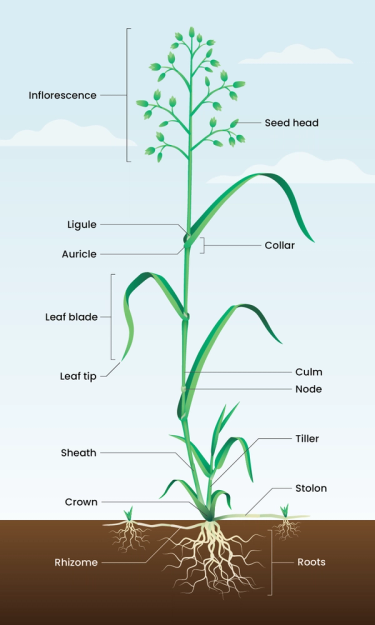
Grass structures and characteristics
Let's get started by reviewing some of the primary grass structures you'll need to know: ligule, collar, and vernation. Once these structures are identified, move on to the other common characteristics to help confirm your grass type.
Ligule
Definition: the appendage/projection near the collar where the sheath and leaf blade meet
Types of ligules: absent, hairy, or membraneous
Sunday Tip:
If a ligule is membraneous then it’s a cool-season grass. If the ligule is hairy or has short hairs, it’s warm-season grass.
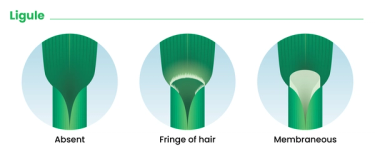
Collar
Definition: where the leaf blade and sheath meet, usually lighter in color than the rest of the blade
Types of collars: continuous, constricted with twist, or divided
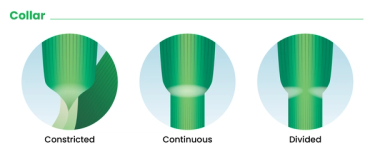
Vernation
Definition: the arrangement of leaves within the shoot
Types of vernation: folded, rolled
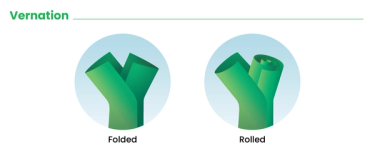
Growth habit
Definition: the method in which the grass spreads and produces shoots
Types of growth habitats
- Rhizomes/rhizomatous: horizontal stem that grows underground and produces lateral shoots
- Stolons/stoloniferous: horizontal stem that grows along the soil surface; can develop roots and shoots at nodes
- Bunch-type, bunch: does not produce stolons or rhizomes
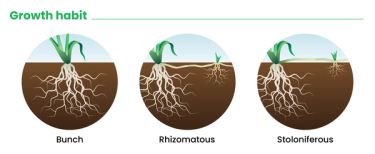
Leaf tip
Definition: the tip of the grass blade
Types of leaf tips: boat-shaped, pointed, or rounded
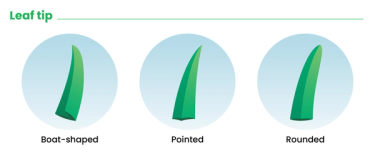
Leaf blade venation
Definition: the pattern of veins in the blade of a leaf
Types of venation: present/prominent (coarse), midrib or spine-like, not present
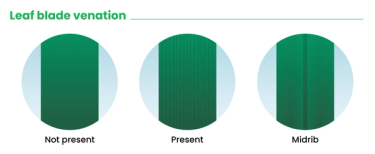
Auricles
Definition: the claw-like projections at the collar
Types of auricles: long/claw-like, short/stubby, or absent
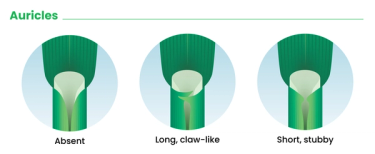
Sheath
Definition: the portion of the leaf that wraps around the stem
Types of sheath: split overlap, fused tube
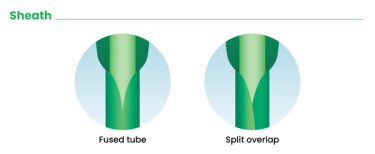
How to identify grass in your lawn
Now that you know the steps to identify mowed grass and how to identify turfgrass structures, you can determine which grass type or types you have. We recommend to first narrow your choices down by determining if you have a warm-season lawn or a cool-season lawn. Start by looking at our north and south divide map.
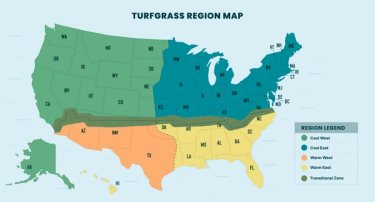
If you’re in the northern region, you will have a cool-season lawn, and if you’re in the south, you’ll have a warm-season lawn. If you’re in the transitional zone – you can have either cool-season or warm-season – but you can determine what type of lawn you have by when your lawn greens up and starts growing. Look for 40-50 degrees F for cool-season, and 60-70 degrees F for warm-season grasses.
Once you’ve determined your lawn type, use our grass type identification charts to identify which grass species is found in your lawn. While these charts do not include every grass that can exist in a home lawn, they include the most common grasses found in most residential lawns. Note: In cool-season lawns, it’s very common to find more than one type of grass!
Sunday Tip:
Be patient with yourself as you attempt to identify your grass type. Identifying mowed grass is not an easy task and takes practice.
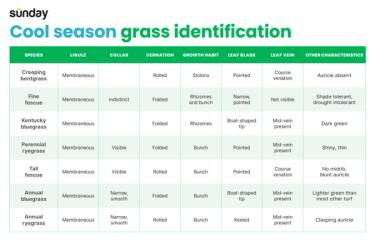

Cool-season grasses
Bentgrass (Idaho, velvet, creeping, colonial)

Agrostis spp. (A. stolonifera, A. palustris)
Growth habit: Stoloniferous (get it...stolons?)
Adaptation: It does well in a wide variety of soil types, but is utilized primarily on golf courses, exotic lawns, and tennis courts due to its ability to be mown very short. It doesn't tolerate heat well and is susceptible to fungal diseases like dollar spot and anthracnose.
Quick ID: Fine leaf texture with coarse veins, pointed leaf tip, and rolled vernation
Recommended maintenance: Mow shorter than ¼ inch. Bentgrass is prone to thatching. Keep nutrient inputs (particularly nitrogen) very low to discourage annual bluegrass. Deep and infrequent irrigation is required.
Establishment: Seed 0.5–2.0 pounds / 1000 square feet; germinates in 7–10 days
Fun fact: Bentgrass can be a nuisance grass in bluegrass or perennial ryegrass lawns—if grown past the ¼ inch height, it tends to look flopped over and untidy.
Sunday select: Sunday doesn’t have seed products with bentgrass, but recommends Kentucky’s Best or Bare Repair Sun + Shade to add diversity.
Sunday Tip:
With such short mowing requirements, bentgrass is quite susceptible to issues with cutting leaf blades too short and causing crowns to be chopped off (a.k.a., die). Follow our dos and don’ts of mowing to ensure proper mowing technique.
Fine fescue
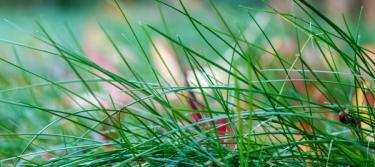
Festuca spp. (F. rubra, F. trachyphylla, F. ovina)
Growth habit: Almost all fine fescues are bunch-type, except creeping red fescue, which is rhizomatous.
Adaptation: It's very tolerant of shade (the most of cool-season grasses!), but susceptible to heat and drought, and not tolerant of heavy traffic. If too moist, it can be susceptible to disease, especially red thread. It's adapted to acidic, infertile soils; too high of fertility can cause thatch production.
Quick ID: Very fine needle-like leaves, folded vernation
Recommended maintenance: Mow 4–6 inches. It needs minimal irrigation (2–3 times / week) and has low nitrogen requirements.
Establishment: Seed 2–5 pounds / 1,000 square feet; it germinates in 10–14 days.
Fun fact: Many varieties of fine fescue contain endophytic fungi. Endophytic fungi live in the grass and produce chemicals that deter surface-feeding insects like chinch bugs!
Sunday select: Shade Select, Lucky Lawn, Bare Repair Sun + Shade
Kentucky bluegrass
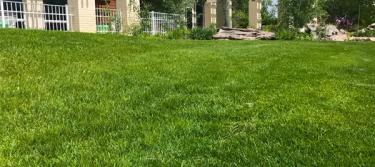
Poa pratensis
Growth habit: It's rhizomatous, which allows Kentucky bluegrass to form sod and recover quickly from damage.
Adaptation: It prefers full sun to moderate shade, and well-drained, fertile soil. It's tolerant of drought and able to withstand heavier traffic. It's prone to root-feeding insects like white grubs and billbugs.
Quick ID: Dark green medium to fine-textured leaves, with light-colored lines on both sides of the midrib and a boat-shaped tip. Short membranous ligule. Folded vernation.
Recommended maintenance: Kentucky bluegrass is one of the most commonly used species for lawns in the U.S. because it withstands high traffic and is low maintenance. Mow 4–6 inches, water deeply and infrequently, and watch for excessive thatch from rhizomes.
Establishment: Seed 1–2 pounds / 1,000 square feet; it germinates in 17–21 days.
Sunday select: Kentucky’s Best
Sunday Tip:
Kentucky bluegrass is often confused with tall fescue and/or perennial ryegrass but has a distinctive boat-shaped tip to distinguish from other species!
Perennial ryegrass
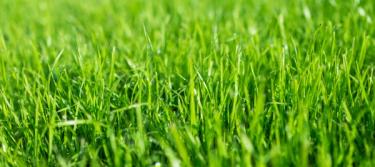
Lolium perenne
Growth habit: Bunch-type that grows laterally through tillers, or the above-ground shoot that comes from the parent shoot. This grass is fast-growing—aka, it germinates and establishes very quickly!
Adaptation: Intolerant of drought, shade, extreme cold, and heat. While very traffic- and pet waste–tolerant, it's prone to disease in warm areas.
Quick ID: Dark greenish-blue color with a pointed leaf tip. Folded vernation and a short, membranous ligule.
Recommended maintenance: Mow 4–6 inches. Water deeply and infrequently. Be mindful, perennial ryegrass leaves are stiffer than other turfgrasses. Keep mower blades sharp to avoid shredding the leaves.
Establishment: Seed 2–5 pounds / 1,000 square feet; it germinates in 4–7 days.
Sunday Tip:
Perennial ryegrass is commonly used on professional sports fields because it’s very traffic tolerant, and its shinier leaf blade allows for decorative lines and patterns (you can try this on your home lawn too!).
Tall fescue
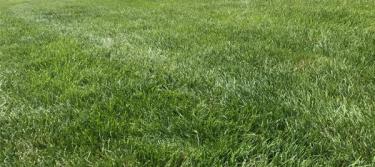
Schedonorus arundinaceus
Growth habit: Bunch-type that spreads through tillers
Adaptation: It's tolerant of high traffic, heat, and drought due to its deep root system. Tall fescue is usually disease resistant but can be susceptible to disease under warm, humid conditions.
Quick ID: The backside of the leaf blade is glossy, and the leaves have coarse venation but don’t have a clear central vein. Leaf edges are rough. Rolled vernation.
Recommended maintenance: Tall fescue is a relatively low-maintenance cool-season variety and doesn’t need routine irrigation or fertilizer. Mow 4–6 inches. Water deeply and very infrequently.
Establishment: Seed 2–8 pounds / 1,000 square feet; germinates in 10–21 days. Overseeding is required to maintain density in high-traffic zones.
Sunday select: Fescue Rescue, Lucky Lawn
Sunday Tip:
Just like fine fescues, many varieties of tall fescue contain endophytic fungi, which help protect them against stress!
Bonus! Other cool-season grasses to know
Annual bluegrass
Poa annua
- Wide distribution, but thrives in cool temperatures
- Intolerant of heat and drought
- Considered a weed in turfgrass, and very difficult to remove once established
- Produces large quantities of seed even when mowed very short
Annual ryegrass
Lolium multiflorum
- Also known as "Italian ryegrass"
- Aggressive seedling growth, and utilized as a “nurse” or cover crop for a more resilient, desired species
- Added to many lower-quality seed patch mixes due to low seed cost
- High annual die-off rate—intolerant of temperature extremes
Warm-season grasses
Bermudagrass
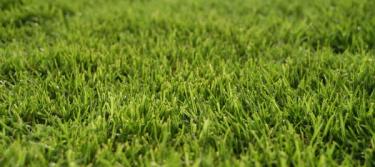
Cynodon spp.
Growth habit: Grows aggressively by stolons and rhizomes.
Adaptation: Is not adapted to shade or cold, but is very tolerant of traffic and drought
Quick ID: Light to dark green, fine- to medium-textured leaves. Folded vernation and a hairy ligule.
Recommended maintenance: Mow 2–3 inches. Water deeply and infrequently.
Establishment: Hybrid varieties must be established vegetatively via plugs, sprigs, or sod. Common varieties can be seeded with 1–2 pounds / 1,000 square feet; germinates in 10–30 days.
Sunday select: Bermuda Time, Bare Repair Bermudagrass
Sunday Tip:
Bermudagrass is considered a noxious weed in many states due to its aggressive growth habit. Make sure you check your local restrictions before planting!
Buffalograss

Bouteloua dactyloides
Growth habit: Stoloniferous
Adaptation: It's very drought and heat tolerant, which makes it a great option for non-irrigated lawns. It's not shade or traffic tolerant, though, and does not do well in heavy-rainfall areas.
Quick ID: Light grayish-green or blue-green hairy leaves with a fine texture. Rolled vernation and a hairy ligule.
Recommended maintenance: Mow 1 inch for vegetatively established cultivars or 2–3 inches for seeded cultivars. It requires little fertilization and no irrigation.
Establishment: Some cultivars can be seeded at 1–1 ½ pounds / 1,000 square feet; it germinates in 10–15 days. Some cultivars are better propagated vegetatively.
Sunday Tip:
Buffalograss is native to the U.S. and is dioecious (has separate male and female plants)! If established vegetatively, female plants are usually preferred, since their seed stalks are smaller.
Centipedegrass

E. ophiuroides
Growth habit: Slow growing by stolons
Adaptation: It's a good option for low-maintenance turf, but is not cold, shade, or traffic tolerant.
Quick ID: Yellow-green, coarse-textured leaves. Folded vernation, with a membranous ligule with short hairs.
Recommended maintenance: Requires infrequent mowing and fertilization. Mow 2–3 inches. Water deeply and infrequently.
Establishment: Primarily vegetative via sprigs, sod, or plugs; some varieties can be seeded but the establishment is very slow.
Sunday Tip:
Centipedegrass and St. Augustinegrass can be easily confused. To tell them apart, look at the nodes! Centipedegrass has alternating leaves but St. Augustinegrass leaves are opposite one another at the nodes. Centipedegrass also has a more pointed, slender leaf blade than St. Augustinegrass.
Kikuyugrass
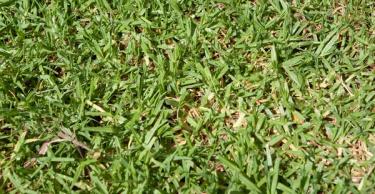
Pennisetum clandestinum
Growth habit: Stoloniferous and rhizomatous
Adaptation: Grows in moist, fertile soils, but is best adapted to elevations above 6,000 feet.
Quick ID: Light green, though male flowers can rise above the turf and add a silvery sheen. Folded vernation and a hairy ligule.
Recommended maintenance: Mow 0.5–2 inches often—Kikuyugrass grows rapidly, so more frequent mowing may be necessary to avoid cutting too short, which can damage the growing point and violate the ⅓ mowing rule! Prone to thatch accumulation. Water deeply and infrequently.
Establishment: Vegetative propagation through sod or plugs
Fun fact: Originating from eastern Africa, Kikuyugrass is named after an indigenous tribe by the name of Kikuyu located near Mt. Kenya. While this grass originates from Africa, it’s only found on the California coast where the climate is similar to that of its origin.
St. Augustinegrass
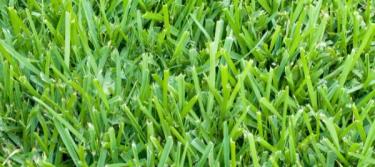
Stenotaphrum secundatum
Growth habit: Stoloniferous
Adaptation: It's the least cold-tolerant of all warm-season grasses, but is relatively shade-tolerant (for a warm-season grass).
Quick ID: Medium to dark green coarse-textured leaves with a crease and a blunt leaf tip. Folded vernation and a hairy ligule.
Recommended maintenance: Mow 2–3 inches. Water deeply and infrequently.
Establishment: Vegetative via plugs, sprigs, sod
Zoysiagrass
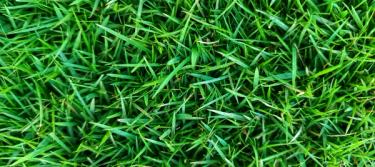
Zoysia spp. (Z. matrella, Z. japonica)
Growth habit: Stoloniferous and rhizomatous, with very slow growth.
Adaptation: It's drought-, heat-, and relatively cold-tolerant for a warm-season grass. Zoysiagrass is slow to establish and recover from damage, so it isn’t the best option for heavily trafficked areas.
Quick ID: Usually one of the first warm-season grasses to green up in the spring. Stiff leaf blades, light to medium green in color. Rolled vernation and a hairy ligule.
Recommended maintenance: Mow 2–3 inches. Water deeply and infrequently. Zoysiagrass leaves are stiffer than other turfgrasses. Keep your mower blades sharp to avoid shredding the leaves.
Establishment: Vegetatively via sprigs or plugs.
Bonus! Other warm-season grasses to know
Bahiagrass
Paspalum notatum
- Aggressively rhizomatous and stoloniferous
- Identified by "Y-shaped" seed head, light color, and coarse texture
- Tolerant of drought and a wide variety of soils
- Can be weedy in desirable turf
Seashore paspalum
Paspalum vaginatum
- Aggressively rhizomatous and stoloniferous
- Medium to coarse texture
- Requires frequent mowing but is difficult to mow and recovers slowly from mowing damage
- High tolerance for heat and somewhat tolerant of traffic, shade, and wear
- Very salt-tolerant—is utilized in coastal areas where soil or irrigation water has a high salt content
Cited sources
Forage Information System. Oregon State University.
Kikuyugrass: Out of Africa. Golf Course Management.
Turfgrass Identification. The Ohio State University.
Turfgrass Species and Variety Guidelines for NYS. Cornell University College of Agriculture & Life Sciences.
Turfgrasses. NC State University.
Turf Species. University of California, Agriculture and Natural Resources.












